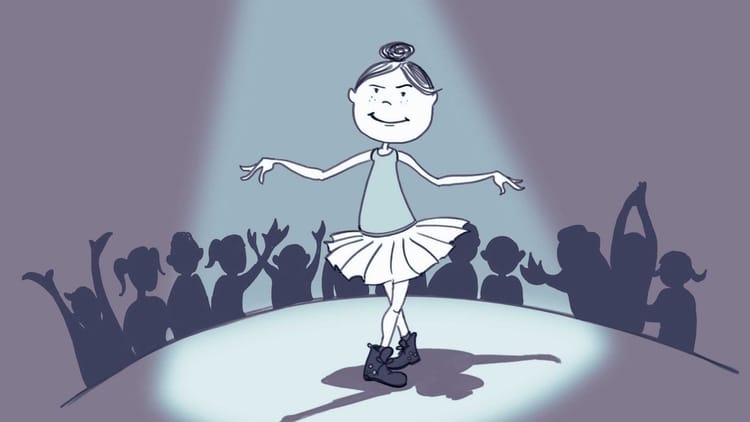I later learned that the human face has 43 muscles that control facial expressions like smiling, smirking, and frowning.
Imagine how hard it would be to model in a 3D DCC tool!
Without going that far, animators use various techniques to create the illusion of talking characters. This process is called lip-syncing. 🎙️✨
In this article, we explore how lip-syncing works and how it enhances storytelling in animation. I hope it helps you improve your drawings! 🎨📚
What's Lip Syncing?
Lip-syncing is about matching the mouth movements of animated characters to spoken dialogue or sound.
Because there is much more going on in your face when you say a word, lip-syncing also considers the character's eyes, cheeks, teeth, and chin, among other facial aspects!
It's a complex task, but essential to creating engaging animations for several reasons.
Why Lip Syncing?
Dialogue is a central part of the story.
Synchronizing a character's lip movements with dialogue makes them feel more lifelike.
How a character moves their mouth while speaking—whether smiling, shouting, whispering, or being sarcastic—conveys their personality, mood, and intent to communicate subtle dialogue that text alone cannot capture.
Studios that take the time to synchronize lips with speech well demonstrate attention to detail. For example, you expect hyper-realist 3D animated movies like Avatar to spend a bigger part of their budget on lip-syncing.
But basic lip-syncing wouldn't appear out of place in a show like South Park.
Poorly synced lip movements distract and pull the viewer out of the experience if it doesn't match the level of realism. This is why animators who take care of lip-syncing have a process and best practices.
1. Preparing the Dialogue
Before everything else, you need to get the dialogue right. Every word, tone, and inflection the characters will express throughout the animation must be agreed upon.
Voice actors then record their lines, adding the emotional nuances that bring their characters to life. For example, a character's happiness would be reflected in a higher pitch tone, with distinctive diction and pacing. Recording sessions allow for multiple takes and delivery variations to pick the best ones.
The recorded dialogue is edited for quality and timing. Sound engineers remove unnecessary noises, awkward pauses, and inconsistencies that could distract or disrupt the listening experience. The result is a clean audio track that animators can use as the primary reference point for animators during the lip-syncing process.
2. Timing and Analysis
The first step is to break down the audio track into individual sounds known as phonemes.
Phonemes represent the smallest units of sound in speech, like the vowels and consonants "A," "B," and "S." Each phoneme corresponds to a specific mouth shape.
Animators create a precise timeline for the animation, marking key points in the audio where each sound occurs. Often, this is done frame by frame to allow animators to synchronize visual transitions with the audio accurately.
Determining how many frames will be dedicated to each phoneme is essential. For example, a prolonged vowel sound might require more frames than a quick consonant, ensuring that the rhythm of the animation matches the rhythm of the speech.
To facilitate the animation process, animators develop a phoneme chart that illustrates the relationship between phonemes and their corresponding mouth shapes, known as visemes.
Visemes represent the visual equivalents of phonemes, showcasing the different mouth positions required for various sounds. Depending on the level of realism you want, you don't need to draw all phonemes. Some sounds result in similar mouth movements:
This phoneme chart is a valuable guide for consistent mouth movements throughout the animation.
A dialogue analysis complements the technical breakdown of phonemes and visemes. Animators examine speech's natural cadence and emotional delivery―inflections, pauses, and intonations―to enhance lip-syncing.
Many animated productions have soundtracks in multiple languages. Having well-executed lip-syncing—particularly through flexible or standardized mouth movements—significantly eases this process.
3. Initial Mouth Shapes
Animators begin by sketching out the basic contours of the mouth movements within the framework of the character's speech. The focus is on defining key frames—key points in the animation timeline where the mouth adopts positions for significant phonetic sounds.
For example, if a character says the word "cat," the animator would identify the key mouth shapes for the sounds "k," "a," and "t" before working on a transition between these sounds.
Key poses are linked to specific facial expressions and emotional states of the character, so a character expressing excitement would have more exaggerated mouth shapes.
Timing is critical. Animators go back and forth to open and close the character's mouth at the precise moments corresponding to the spoken audio. A character who speaks quickly and with enthusiasm would have faster mouth movements to match their speech.
4. Inbetweening
Animators introduce intermediate frames to bridge keyframes. This inbetweening technique smoothens the transitions between key expressions: the movement of the lips appears less choppy and more lifelike.
Nowadays, it’s more common to use digital interpolation to generate these frames: an algorithm just takes care of deforming the mouth from one state to another. Learn more about interpolation in our dedicated article.
Lip-syncing does not occur in a vacuum; it is connected to the character's full range of expression. Facial and body animation integrated with lip movements are synchronized with the spoken dialogue and harmonized with the character's facial expressions, head movements, and body language. If a character expresses joy while speaking, the lip sync should reflect that emotion―e.g., a smile and a relaxed posture.
5. Editing
Even slight delays or misalignments between the lip movements and the spoken words can break the illusion, so animators adjust frames and tweak the speed of movements.
Adjusting visemes to integrate more subtle phonemes can take the animation quality further, so it can make sense if the budget allows it to emphasize the clarity of sounds and refine jaw movements to create a more believable speech pattern.
Because animation is an iterative creative process, it's not uncommon to share feedback and do retakes on a daily basis.
6. Rendering
Rendering generates the final animated frames that incorporate lip sync, character movements, background elements, special effects, etc.
It's a resource-intensive process, depending on the scene's complexity and the desired output's quality. High-quality renders take much longer to produce but improve the visual appeal of the animation.
This is why teams must schedule rendering times appropriately to allow for high-resolution outputs where necessary while avoiding bottlenecks in production schedules.
To minimize wait times, animation studios rely on advanced animation pipelines to manage their assets and render farms―clusters of powerful computers used to render animations efficiently.
7. Audio and Animation Integration
The final audio syncing re-aligns the animation with the final audio track, taking into account any last-minute changes in timing that may have occurred during production.
In the compositing phase, animators focus on creating a cohesive scene where lip-syncing works harmoniously with special effects, lighting, and other animation elements.
Audio scrubbing is one of the most effective techniques for ensuring precise phoneme alignment. The sound engineer plays the audio file frame by frame to inspect how well the lip movements correspond to the dialogue. By meticulously analyzing each phoneme and comparing it with the corresponding mouth shapes, animators can identify any discrepancies in lip-syncing.
8. QA and Final Delivery
During the Quality Assurance phase, animators meticulously examine the animation frame by frame to verify that the lip-syncing is consistent across various shots.
Once the QA process is complete, the project moves to the final delivery phase. The entire scene—including the meticulously synced lip movements—is rendered in its highest quality. This final render is an opportunity to polish the animation for its intended release format: television, film, or digital platforms. Lip-syncing for different release languages can also happen here.
It's also prudent to conduct a final review of the animation under various viewing conditions—different screen sizes and settings—to ensure that the lip-syncing appears seamless in any context.
Conclusion
Lip-syncing is key to breathing life into characters. From dialogue preparation and phoneme analysis to the final touches in QA, animators ensure that every mouth movement aligns accurately with the speech to help audiences connect deeply with the characters and story.






